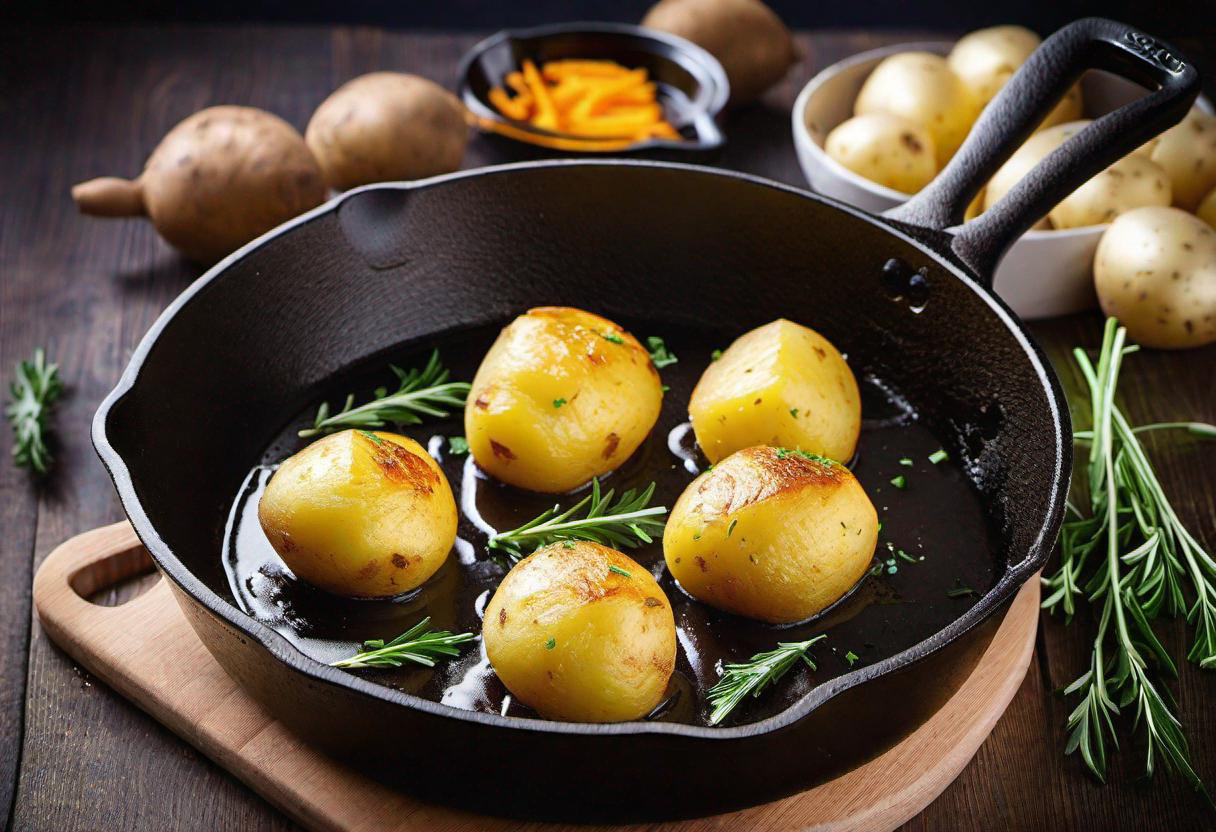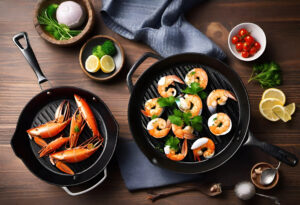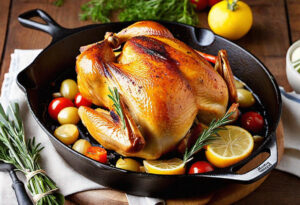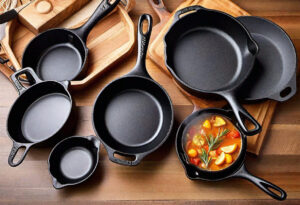If you’re a cooking enthusiast like me, you’ve likely come across the term “seasoning a cast iron pan,” but what does it actually mean and why is it important? Seasoning refers to the process of coating your cast iron pan with a layer of oil and baking it, which creates a natural non-stick surface.
This not only enhances the flavor of your food but also improves the durability and longevity of your cast iron pan. In this article, we will explore the various factors that make seasoning so crucial, including heat retention and distribution, durability, versatility, maintenance and care, health and safety, cost and accessibility, and more.
By understanding the importance of seasoning, you’ll be able to make more informed decisions about your cooking tools and achieve delicious results in your kitchen.
Key Factors for Evaluation
A. Heat Retention and Distribution
When evaluating the suitability of cast iron pans for different cooking scenarios, one of the key factors to consider is heat retention and distribution. Cast iron has long been renowned for its ability to retain heat and distribute it evenly across the cooking surface. This is due to its high thermal mass, which allows it to absorb and hold heat for extended periods of time.
To assess the heat retention and distribution capabilities of cast iron pans, it is important to compare them with other popular cookware materials such as stainless steel and non-stick coatings. Stainless steel is known for its efficient heat distribution but may not retain heat as well as cast iron. Non-stick coatings, on the other hand, often have poor heat retention properties.
B. Durability and Longevity
Another important factor to consider is the durability and longevity of cast iron pans. Cast iron cookware is known for its robustness and ability to withstand high temperatures and heavy use. It is resistant to wear, rust, and deformation, making it a long-lasting option for cooking.
When comparing the durability and longevity of cast iron pans to other types of cookware, it is important to consider factors such as the quality of the materials used, the thickness of the cookware, and the manufacturing processes employed.
Cast iron pans are often thicker and more solidly constructed than other types of pans, which contributes to their longevity.
C. Versatility
Cast iron pans are prized for their versatility in the kitchen. They can be used in a wide range of cooking methods, including frying, baking, searing, and roasting. The ability to go from stovetop to oven makes cast iron pans suitable for many different dishes and cooking techniques.
To assess the versatility of cast iron pans, it is important to consider the range of dishes that can be prepared using this type of cookware. From crispy-skinned chicken to perfectly seared steaks, cast iron pans can handle a variety of recipes and cooking styles. Additionally, the ability of cast iron to provide even heat distribution contributes to its versatility in achieving consistent cooking results.
D. Maintenance and Care
Maintenance and care requirements are important considerations when evaluating cast iron pans. One of the unique aspects is the process of seasoning, which involves coating the pan with a layer of oil or fat and baking it.
Seasoning not only enhances the non-stick properties of the pan but also creates a protective layer to prevent rust and improve durability.
Compared to other materials such as stainless steel and non-stick coatings, cast iron pans may require more attention in terms of cleaning and seasoning. It is important to avoid using harsh detergents and abrasive scrubbers that can remove the seasoned layer. However, with proper care and maintenance, cast iron pans can last for generations.
E. Health and Safety
Health and safety are paramount when it comes to choosing cookware. Cast iron pans have been used for centuries, and they are generally considered safe for cooking. In fact, cooking with cast iron can have potential health benefits.
Cast iron pans may leach small amounts of iron into the food, which can be a positive attribute for individuals with iron deficiencies. However, for those with iron overload conditions, it may not be desirable. Additionally, some individuals may be concerned about the potential for food sticking to the surface of a cast iron pan, which can be mitigated by proper seasoning and cooking techniques.
When comparing the health and safety aspects of cast iron pans with other cookware materials, it is important to consider factors such as the presence of harmful chemicals in non-stick coatings and the potential for leaching or reaction with acidic foods in certain materials.
F. Cost and Accessibility
Cost and accessibility are practical factors that can influence the choice of cookware. Cast iron pans are generally considered more affordable compared to high-end stainless steel or non-stick pans. They are widely available in various sizes and shapes, making them accessible to a wide range of consumers.
When evaluating the cost and accessibility of cast iron pans, it is important to consider the initial investment as well as the long-term value. Although cast iron pans may require more care and maintenance, their durability and longevity can make them a cost-effective choice in the long run.
Methodology
Research Methods and Sources of Data
To assess the suitability of cast iron pans and determine if they can be considered the best choice for various cooking scenarios, a comprehensive research methodology will be employed. This will involve gathering relevant information from various sources, including scientific studies, expert opinions, and user reviews.
Scientific studies can provide valuable insights into the heat retention and distribution capabilities of cast iron pans, as well as their durability, maintenance requirements, and potential health concerns.
Expert opinions from chefs and culinary professionals can offer practical advice and perspectives on the use of cast iron pans in different cooking scenarios. User reviews and personal anecdotes can provide real-world experiences and insights into the performance and versatility of cast iron pans.
This image is the property of pixabay.com.
Data Collection
Gather Relevant Information
To collect relevant information for the evaluation of cast iron pans, a thorough review of scientific literature, culinary resources, and user experiences will be conducted. This will involve analyzing studies and articles that specifically focus on heat retention and distribution, durability, versatility, maintenance, health and safety, and cost and accessibility of cast iron pans.
In addition to scholarly sources, culinary resources such as cookbooks, cooking websites, and online communities centered around cast iron cooking will be consulted. These sources can provide practical insights and recommendations based on the experiences of home cooks and professional chefs.
Conduct Experiments or Surveys
If necessary, experiments or surveys may be conducted to obtain empirical data on specific aspects of cast iron pan performance. This could involve measuring heat distribution across the cooking surface, conducting controlled cooking tests using different cookware materials, or surveying individuals to gather their experiences and preferences regarding cast iron pans.
By combining data from scientific studies, expert opinions, and user experiences, a comprehensive understanding of the performance and suitability of cast iron pans can be achieved.
Analysis
Evaluate Collected Data
Once the relevant data has been gathered, it will be analyzed to draw conclusions about the performance of cast iron pans in each of the key factors for evaluation. This analysis will involve comparing the data from different sources and identifying trends or patterns that emerge.
For example, if multiple scientific studies consistently indicate that cast iron pans have superior heat retention capabilities compared to other materials, this would support the conclusion that cast iron is an excellent choice for achieving even cooking results. Similarly, if user reviews consistently highlight the durability and longevity of cast iron pans, this would further validate their reputation as long-lasting cookware.
By critically evaluating the collected data, a reliable and comprehensive assessment of the performance of cast iron pans can be achieved.
This image is the property of pixabay.com.
Comparative Assessment
Compare the Performance of Cast Iron Pans
To determine the suitability of cast iron pans in various cooking scenarios, it is important to compare their performance with other common cookware materials. This will involve assessing how cast iron pans fare in terms of heat retention and distribution, durability and longevity, versatility, maintenance and care, health and safety, and cost and accessibility.
By comparing the performance of cast iron pans with other types of cookware, a clear understanding of their advantages and disadvantages can be obtained.
Highlight the Advantages and Disadvantages of Cast Iron Pan
Based on the comparative assessment, it is important to highlight the specific advantages and disadvantages of using cast iron pans. This will involve discussing the strengths, such as its excellent heat retention, durability, and versatility.
It will also address any potential drawbacks, such as the need for regular seasoning and possible leaching of iron into food.
By providing a comprehensive overview of the advantages and disadvantages, individuals can make informed decisions about whether cast iron pans are the best choice for their specific cooking needs.
Contextualization
Consider Specific Cooking Techniques, Cuisines, and Personal Preferences
To fully evaluate the suitability of cast iron pans, it is important to consider the specific context in which they are used. This includes the cooking techniques, cuisines, and personal preferences of individuals.
For example, cast iron pans may be particularly well-suited for certain cooking techniques, such as searing or baking, due to their ability to distribute heat evenly. Similarly, certain cuisines may benefit from the unique properties of cast iron, such as the ability to retain high temperatures for stir-frying.
Personal preferences also play a significant role in determining the best choice of cookware. Some individuals may prioritize the ease of maintenance and care, while others may value the health benefits of iron leaching into the food.
By considering the specific context in which cast iron pans are used, a more nuanced understanding of their suitability can be achieved.
This image is the property of pixabay.com.
Conclusion
Summarize Findings from Evaluation
Based on the evaluation of the key factors, the comparative assessment, and the contextual considerations, it is now possible to summarize the findings regarding the suitability of cast iron pans.
The conclusion will summarize the performance of cast iron pans in terms of heat retention and distribution, durability and longevity, versatility, maintenance and care, health and safety, and cost and accessibility. It will determine whether cast iron pans can be considered the best choice for specific cooking scenarios or if other materials may be more suitable.
Recommendations
Provide Recommendations Based on Conclusion
Based on the conclusion drawn from the evaluation, it is important to provide recommendations for the best choice of cookware in different cooking scenarios.
These recommendations will be based on factors such as the specific cooking techniques, cuisines, and personal preferences discussed in the contextualization section. They will highlight when and where cast iron pans are the best choice and when other types of cookware may be preferred.
Future Research
Suggest Potential Areas for Further Research
While this evaluation provides a comprehensive understanding of the performance and suitability, there are always opportunities for further research and exploration.
By identifying potential areas for future research, individuals can contribute to the ongoing understanding of cast iron cookware and potentially uncover new insights or innovations.
References
Cite Sources and Studies Used for Evaluation
To ensure the credibility and transparency of the evaluation, all sources and studies used throughout the research process will be properly cited. This includes scholarly articles, culinary resources, user reviews, and any other relevant sources of information.
By providing a comprehensive list of references, individuals can further explore the subject of cast iron pans and verify the information presented in the evaluation.
Happy cooking!






